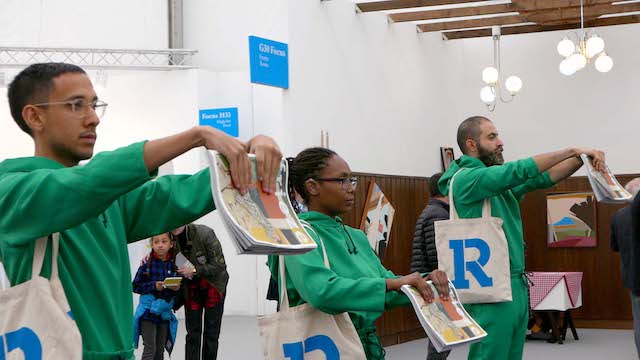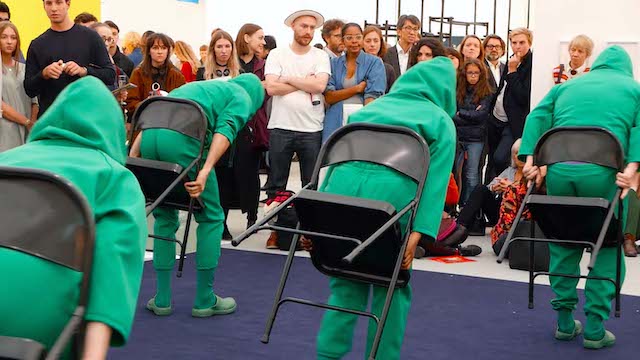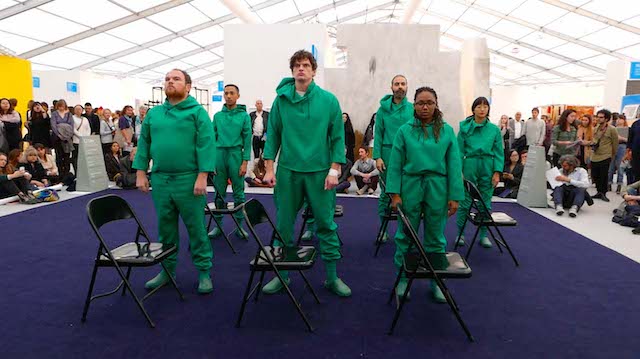“I am trying to be unfamiliar with what I’m doing.” ― John Cage
Christine Sun Kim was born deaf to hearing parents. As her parents learned American sign language to better communicate with their daughters, Kim became aware of an imbalance and misunderstanding implicit in the interaction. A hearing person may communicate with the conviction of the other’s lack- as though they know what sound is and can translate or bestow it.
However, Kim does not experience a lack. She recalls an insight she had as a young artist: “I was taught that sound was never going to be part of my life… for a long time I felt the need to create art, but whenever I was painting, I saw other people’s voices in my paintings.” Her artwork is built around an exploration and reclamation of sound and its ecology, on her own terms.
During an artist-residency in Berlin, Kim began to transition away from her painting practice, noting that sound was a medium with greater capacity to capture the expanse and totality of her experience of being alive. Her approach to sonic art, however, is not so much about the reproduction of found sounds, or the creation of new compositions; it involves a dismantling of what we know about sound and the creation of authentic sonic encounters.
A prolific multimedia artist, Kim began to incorporate sound, performance, and participatory actions to her ongoing paper-based works. She also has a significant online presence (coming to the attention of wider audiences when she performed the Star-Spangled Banner at ‘Superbowl’ in 2020). Her interviews, public talks (she is a Ted Fellow) – and a notable short documentary about her work by director Todd Selby – are always illustrated with aspects of her engaging art-making processes. They also provide an insight to the humour and creative force of the artist.
Kim encourages her audiences to question all they think they know about sound and silence. Further, she incites an examination of our assumptions about D/deafness and the way we, as hearing people, are implicated in the oppressive conditioning, or what Kim refers to as the colonisation, of D/deaf people.
She highlights issues such as the silencing of D/deaf people, the denial of the validity of their language and the pervasive message of the inferiority of their social behaviours: “While growing up I constantly questioned the ownership of sound. People who have access to sound naturally own it and have a say in it. There were all these conventions for what was proper sound. They would tell me ‘Be quiet’, ‘Don’t burp’, ‘Don’t drag your feet’ ‘Don’t make loud noises’. I learned to be respectful of ‘their’ sound. I saw sound as their possession. Now I’m reclaiming sound as my property.”

Kim investigates these patterns of social and verbal directives in terms of micro-aggressions and is informed by the concept of ‘grammars of power’ – an intersectional and politicised extension of Francis Dyson’s ‘human conversational protocols’. Kim cites video-captioning as an example of a linguistic device which functions to gate-keep and shape content. Captions often attempt to condense information and affect-rich screen moments to a single word.
For example, the nuances of soundtrack music are often overlooked and deemed irrelevant: “If I’m lucky, maybe I’ll get [violin music] which is better [than just music], but still not enough. It doesn’t tell me anything about what that sound is made of – how it moves, it’s personality. The more description, the better. So, for instance, mournful violin music or mournful violin music that sounds like crying alone in an empty bar.” Kim has filmed a response to such captions in a video work, created for Pop-Up Magazine. The result is a humorous but also evocatively beautiful piece of concrete poetry.
Through her work, Kim shares her own evolving relationship to sound, not solely as an advocate who wishes to create greater understanding for the experience of how D/deaf people perceive sound and silence, but as an act of shared investigation of the unexplored qualities of sound. With hearing and D/deaf audiences alike, she explores the multifaceted nature of sound, its kinaesthetic origins, and the physical and conceptual impact it has. To Kim, sounds and signals are constantly transmitted to her through various means, and much of her day is spent navigating and making sense of the sounds she feels immersed in.
“So, how is it that I understand sound? Well, I watch how people behave and respond to sound. You people are like my loudspeakers and amplify sounds. And I learn to mirror that behaviour.”
Kim’s ability to communicate complex ideas about deafness and sound to a mostly hearing audience is noteworthy. Artist Seth Kim-Cohen suggests that audiences are primed to attend to what he calls ‘non-cochlear sonic art’, because of the precedent set by artists such as Marcel Duchamp who exposed the art world to ‘non-retinal art’. Non-objective artists use found or mundane objects which discourage aesthetic visual fixation, leading the viewer instead to the conceptual content of the work.
In her performances and recorded sonic works, Kim uses a combination of high and low-tech noise-making and recording devices and techniques, always retaining an aesthetic of the makeshift and a sense of playfulness that increases the audience’s sense of involvement and willingness to listen, even in her most confronting actions.
Nap disturbance, Frieze Gallery, London, 6-9 October 2016
Nap disturbance is a low-tech but highly choreographed performance, which was performed live across three days at London’s Frieze Gallery in October 2016. The work is an operatic re-enactment of the build-up of ‘accidental’ noises that D/deaf people are expected to suppress within their daily lives. The actors stand in formation and in unison pick up their cups and stir imaginary drinks with metal implements; shake out magazines in preparation to read them; shuffle knives and forks around metal containers; stamp their feet or shake their legs; percuss their water bottles and rearrange their chairs, scraping them across the floor – all to optimal sonic effect, while staring at a space beyond the audience.

The sounds of the performance are amplified within the usually ritualistically-silent environment of the art museum and choreographed by a small group of performers bearing and manipulating familiar domestic objects, exploding through the politeness register into a gratingly loud one. It is not a cathartic explosion; it is still constrained and controlled. There is a neutrality to the facial expressions of the performers, but this adds an emotional menace to the performance, as though it is fuelled by the accumulated but unconscious frustration of being silenced.
The choice of green sweatsuits, worn by the actors, is a reference to green screen technology, reiterating the layer of erasure and silencing placed on D/deaf people as layers of atmospheric and foreground noise engulfs the sonic environment.
What seems menacing in Kim’s (admittedly loud) use of sound is the absence of speech to contextualise the sound-actions. A speaking person may sonically (mis)behave in any of the exaggerated ways demonstrated in this performance, but here there is confronting verbal silence that to a hearing person withholds the comforting sense-making that speech provides. As is the case with all situations of colonisation, colonisers experience anxiety at the thought of any redistribution of power or upheaval in the hierarchy. I am overstating the sense of menace in an essentially amusing and vivacious performance, but in this process of de-familiarisation the social-currency or power imbedded in the mechanism of speech is exposed.
In this work, we, the hearing audience, are external observers; we become the other. As Kim expresses it, “being deaf in a sound world is like living in a foreign country”. She considers her work successful if she creates a similar experience for her audiences.
Environmentalist, composer and music educator R Murray Schafer urges us to listen closely and consciously to the soundscapes that we are immersed in and perpetually and unconsciously consume and co-create. Through her oeuvre, Christine Sun Kim makes a similar incitement, inviting us to attend not only to sound as it presents itself externally, but also to listen to the less familiar territory of how sound is experienced internally; to watch for the shadows it casts, the footprints it leaves. To watch with fresh eyes how sound operates upon our lives and those of others.


